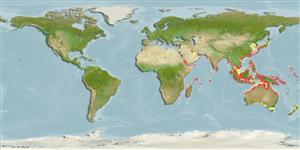>
Carangiformes (Jacks) >
Carangidae (Jacks and pompanos) > Caranginae
Etymology: Atropus: The name of the Parcae, fates of Roman mythology (Ref. 45335).
Eponymy: In Greek mythology, Atropos -known as the ‘inflexible’ or ‘inevitable’ -was the oldest of the Three Fates. In Greek mythology, Atropos -known as the ‘inflexible’ or ‘inevitable’ -was the oldest of the Three Fates. (Ref. 128868), visit book page.
More on authors: Bloch & Schneider.
Environment: milieu / climate zone / depth range / distribution range
Ekologi
laut; amphidromus (Ref. 51243); kisaran kedalaman 5 - 100 m (Ref. 52753). Tropical; 40°N - 12°S, 47°E - 143°E
Indo-West Pacific.
Length at first maturity / Size / Weight / umur
Maturity: Lm 21.0 range ? - ? cm
Max length : 31.6 cm TL jantan/; (Ref. 121654)
Duri punggung (Keseluruhan (total)) : 9; duri punggung lunak (Keseluruhan (total)) : 21 - 22; Duri dubur: 3; Sirip dubur lunak: 17 - 18. This species is easily recognized by its long pelvic fin which fit into a groove along the midline of the belly when depressed. Scutes are present along its straight lateral line. Adult males have prolonged middle rays in the soft dorsal and anal fins. This species attains 25 cm in SL.
Adults are common in shallow coastal waters where they often swim near the surface. They feed mainly on shrimps, copepods, decapod crustaceans and small fish.
Life cycle and mating behavior
Kematangan | Reproduksi, perkembang biakan | Pemijahan | telur-telur | Fecundity | Larva
Masuda, H., K. Amaoka, C. Araga, T. Uyeno and T. Yoshino, 1984. The fishes of the Japanese Archipelago. Vol. 1. Tokai University Press, Tokyo, Japan. 437 p. (text). (Ref. 559)
Status IUCN Red List (Ref. 130435: Version 2024-2)
ancaman kepada manusia
Harmless
penggunaan manusia
Perikanan: nilai komersial kecil
Alat, peralatan
laporan khas
muat turun XML
Sumber internet
Estimates based on models
Preferred temperature (Ref.
123201): 23.5 - 29.2, mean 28.2 °C (based on 1522 cells).
Phylogenetic diversity index (Ref.
82804): PD
50 = 1.0000 [Uniqueness, from 0.5 = low to 2.0 = high].
Bayesian length-weight: a=0.02089 (0.01199 - 0.03640), b=2.86 (2.71 - 3.01), in cm total length, based on LWR estimates for this species & (Sub)family-body (Ref.
93245).
Trophic level (Ref.
69278): 3.6 ±0.52 se; based on food items.
Generation time: 2.0 ( na - na) years. Estimated as median ln(3)/K based on 2
growth studies.
Daya lenting (Ref.
120179): Tinggi, Waktu penggandaan populasi minimum kurang dari 15 bulan (Preliminary K or Fecundity.).
Fishing Vulnerability (Ref.
59153): Low vulnerability (18 of 100).
Nutrients (Ref.
124155): Calcium = 197 [92, 426] mg/100g; Iron = 1.79 [0.95, 3.80] mg/100g; Protein = 18.6 [17.3, 19.9] %; Omega3 = 0.247 [0.129, 0.485] g/100g; Selenium = 51 [23, 115] μg/100g; VitaminA = 14.4 [3.5, 52.1] μg/100g; Zinc = 1.14 [0.73, 1.81] mg/100g (wet weight);
